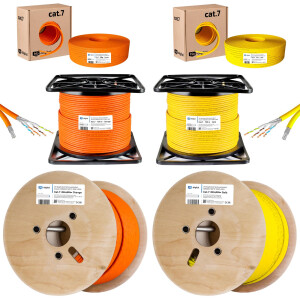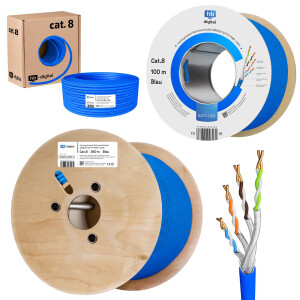Network Cable / Installation Cable
Introduction to network cables
Introduction to network cables is an important part of network design. They ensure that computer systems are networked and data can be transferred quickly. Network cables / installation cables are usually manufactured in different lengths and types. They can be copper or fibre optic, depending on your needs. Copper cables are usually suitable for short distances, while fibre optic cables are suitable for longer distances. The right choice of network cables / installation cables is important to get an efficient network. It is important to consider the requirements and costs to choose the best option. It is also important to ensure that all components of the network are compatible with each other before installing them. A network cable / installation cable must be installed correctly to ensure safe and efficient operation. The most important components for a network include the cable router and the switch. These components are necessary to connect and manage the Network.
Network cable categories (CAT)
Network cables, also known as installation cables, come in different categories called CAT. Depending on the requirements of the network, different categories can be used. CAT 5 and CAT 5e are the most common cables used for home use. CAT 6 and CAT 6A are the newest cable categories and can support the highest data transfer rates. CAT 7 cables are the most powerful cables available on the market, but can only be used in special situations. CAT 7A cables are an improved version of the CAT 7 cable and offer even higher data transmission rates. CAT 8 cables are the latest generation of cables and offer the highest data transmission rates of all cable categories. All cable categories offer the possibility to create and manage both wired and wireless networks.
Network cable connections
Network cable connectors are an important component needed for an efficient network. They allow network devices to be connected to each other via cables. There are different types of cables, such as coaxial, UTP and STP cables, which all have different connectors. Network cables are usually connected to the network device with an RJ45 connector. This connector has an 8P8C socket that makes it easy to connect the cable. The installation of the network cable is usually quite simple and only requires basic wiring. Installation cables are usually thicker and more expensive than network cables. They are usually used to install wireless networks or to connect several types of cables to one device. They can also be used to create more complex networks where multiple network devices are connected together. Network cable connectors are a very important component in any network. They can help create a stable connection and protect against potential problems and malfunctions. Therefore, it is important to choose the right type of cable and connector for your network to ensure that all devices are properly connected.
Advantages of network cables
Network cables / installation cables offer many advantages over wireless technology. They are a very reliable and robust way of transmitting data and can also be used in environments with high electromagnetic interference. They are also very easy to install and manage. Network cables can also be set up in hard-to-reach areas, and the cables are easy to repair if they are damaged. They can also be laid over long distances, making them very suitable for creating networks. Network cables offer excellent connection quality and are usually cheaper than wireless technologies.













